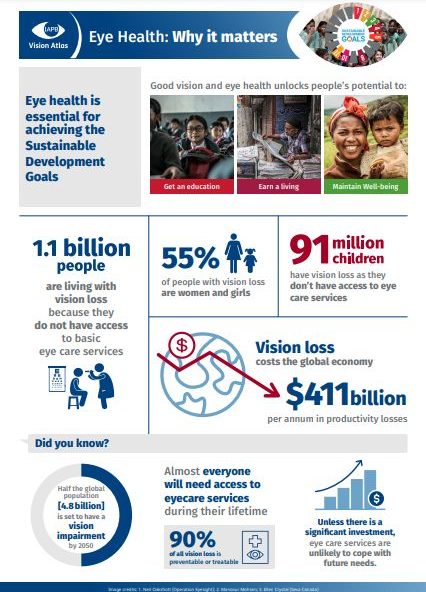 The formal launch of the Vision Atlas of the International Agency for the Prevention of Blindness (IAPB) took place on 24 February 2021. This includes data on the magnitude, the inequalities, the effect and the causes of the situation of the vision in the world and, simultaneously, the report on Global Eye Health was presented from the Global Health Commission of the prestigious scientific magazine The Lancet. This report sets out the key messages and the challenges in the prevention, the assistance and the treatment of eye health, beyond 2020.
The formal launch of the Vision Atlas of the International Agency for the Prevention of Blindness (IAPB) took place on 24 February 2021. This includes data on the magnitude, the inequalities, the effect and the causes of the situation of the vision in the world and, simultaneously, the report on Global Eye Health was presented from the Global Health Commission of the prestigious scientific magazine The Lancet. This report sets out the key messages and the challenges in the prevention, the assistance and the treatment of eye health, beyond 2020.
The Eyes of the world Foundation was present at the high-level virtual event, which was jointly organized by UN Friends of Vision, The Lancet and the IAPB. During the event, they discussed recent data and discoveries, and how to respond to the goals set for the next decade, in compliance with the Sustainable Development Goals (SDGs) of the United Nations.
Across the world, there are 1,1 billion of people with vision loss that affect population groups differently; it is much higher in older people (73% of them are over 50 years of age) and in women, specifically, 55% of people with vision loss are women and girls. Furthermore, 90% of people with vision loss live in low-income and middle-income countries.
However, 90% of vision loss could be prevented or treated: 161 million of people present uncorrected refractive errors, 100 million of people suffer from cataracts and 510 million of people have problems to see up close. Moreover, 91 million of children present vision loss because they don’t have access to vision services.
The bad eye health and the poor vision adversely affect the quality of life of people, their education and employment. In addition, vision loss has substantial financial implications for people, families and communities. The annual loss of global productivity due to visual impairment is estimated to be approximately $ 411 billion per year.
Conversely, the vision unlocks human potential, that is to say, it facilitates many activities of daily life, it allows the improvement of educational outcomes and it increases the labour productivity, reducing inequality. And, at the same time, it enables us to proceed with the SDGs contributing to poverty reduction, Zero Hunger, good health and well-being, quality education, gender equality and decent work.
There are currently cost-effective, evidence-based solutions that help reduce or eliminate blindness. For example, vision screening, glasses and cataract surgery could mitigate the vast majority of vision loss; treatments and procedures that are among the most cost-effective of all medical care.
The lessons of the last three decades gave hope that this challenge could be met. Between 1990 and 2020, the global prevalence of blindness decreased by 28.5% and the main infectious causes of blindness (such as onchocerciasis and trachoma) decreased substantially. However, it is estimated that the growth, the ageing and the urbanization of the population, over the next 30 years will lead to an increase in the total number of people with blindness. Specifically, projections indicate that nearly half of the world’s population will suffer from some form of visual impairment by 2050 and vision loss will increase to 1.7 billion people (600 million more) if no significant investments are made.